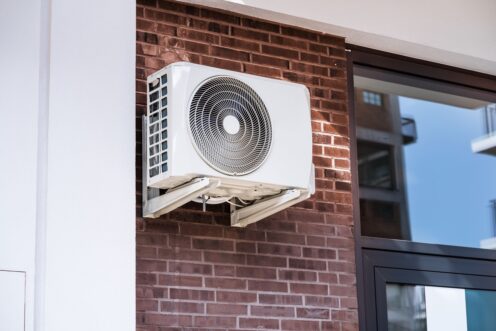If you’re considering a new heating system for your Washington, MO, home, there’s a good chance that a heat pump is among your finalists. However, you may have also encountered a variety of publications claiming that heat pumps make a poor match for regions with cold winters. Specifically, plenty of sources claim that heat pumps don’t do very well at temperatures below 40 degrees Fahrenheit. That’s concerning when you consider that we see at least five months each year with lower average overnight temperatures than that. In reality, though, conventional heat pumps work at low temperatures, but they just may lose a bit of their vaunted efficiency. That’s where dual-source heat pumps make a perfect compromise. Here’s what they are and how they work to maximize your heating efficiency all winter long.
Heat Pumps and Cold Weather
Before we delve into dual-source heat pumps and why they’re a great option for homes in Washington, it’s important to understand how heat pumps work, particularly in cold weather. For starters, heat pumps, unlike other types of heating systems, don’t generate heat. Instead, they use the refrigeration cycle to collect heat energy from the outdoor air, amplify it, and carry it into your home.
The process works because even cold winter air still has a lot of heat energy, even if you don’t feel it. To collect it, heat pumps manipulate the temperature and pressure of a refrigerant, first making it colder than the outside air and then using the temperature differential to absorb heat from the air. Then, they increase the pressure on the warmed refrigerant to increase its temperature and make it hot enough to heat your home.
The trouble is that heat pumps work harder and harder to capture sufficient heat energy when the outside temperature drops. That’s where the notion of heat pumps struggling below 40 degrees Fahrenheit comes from. The truth is, however, that the average heat pump will still be more efficient than the average gas furnace until the outside temperature drops below 25 degrees Fahrenheit. At that point, they may need to engage a backup electric heating element to supplement the heat they collect from the outside.
Do All Heat Pumps Struggle in the Cold?
At this point, it’s worth noting that not every heat pump struggles in very cold weather. Today, there are a variety of heat pump models built specifically for use in cold climates. They have much wider operating temperature ranges, with some systems working efficiently down to -15 degrees Fahrenheit. However, that extra performance comes at a cost.
Cold climate heat pumps employ next-generation refrigerants and advanced technology to squeeze as much heat energy out of sub-freezing air as possible. As a result, they can cost significantly more than standard heat pumps. The good news is, however, that cold-climate heat pumps aren’t the only option for people living in places with cold winters. Dual-source heat pumps offer efficient and plentiful heat at any temperature and can cost less than a cold-climate heat pump.
What’s a Dual-Source Heat Pump?
Where a standard heat pump relies on heat strips, which are small electric resistance heating elements to provide a secondary heat source, dual-source heat pumps include a small gas-fired heating system. The idea is to have a second high-efficiency heating option for use when temperatures drop too low for a heat pump to work well.
Some dual-fuel systems use a preset temperature to control which heat source gets used when. For example, you may configure a dual-source heat pump to switch to the gas burner when the temperature drops below freezing. In that way, you guarantee that your home has sufficient heat and that you’re generating that heat in the cheapest way possible.
Some dual-source heat pumps can even make the decisions for you. They monitor the performance of their included heat pump and compare it to the known efficiency of the included gas burner. Once they determine that the heat pump has dropped below the efficiency of the gas burner, they’ll switch over. Then, they’ll switch back once outside temperatures rise enough to make the heat pump the better option.
Using a dual-source heat pump guarantees that you will always heat your home while saving the maximum amount of energy possible. When you consider that according to the US Energy Information Administration, space heating accounts for 42% of residential energy use, that’s a big deal. According to the EPA, homes with dual-source heat pumps can cut their winter heating bills by as much as two-thirds.
It also guarantees that your home will be comfortable all winter long. Owners of heat pumps often complain of a drafty feeling when the temperature outside drops significantly. This is because heat pumps only produce air that’s between 100 and 115 degrees Fahrenheit. While that’s enough to heat your home, it’s close enough to your body temperature that it may not feel very warm. A dual-source heat pump, by contrast, switches to its gas burner in cold weather, which eliminates that problem. In that mode, a dual-source heat pump works exactly like a conventional gas furnace, churning out hot air that’s 140 degrees Fahrenheit or more.
Dual-Source Heat Pump Considerations
Dual-source heat pumps make a great option for the majority of homes here in Washington. However, there are some things you should consider before choosing one. The first is whether or not your home already has a natural gas supply line. If it doesn’t, putting one in can substantially add to your installation costs. In that situation, the cost advantage enjoyed by dual-source heat pumps versus cold-climate heat pumps evaporates quickly.
The same is true if your home currently has a boiler or other hot water-based heating system. Dual-source heat pumps rely on in-wall ductwork to carry warm air throughout your home. Retrofitting your home to include that ductwork can be both prohibitively expensive and disruptive. However, you can still take advantage of the efficiency of a heat pump in the form of a ductless mini-split system, provided that you install one rated for use in cold climates.
The Dual-Source Heat Pump Specialists
If you believe that a dual-source heat pump is a good option for your home, Level 9 Heating, Cooling, and Plumbing can help. We’ve served the local area since 1975, offering top-quality HVAC installation, HVAC maintenance, and HVAC repair services. That includes selling and installing the latest in dual-source heat pump systems. We also offer plumbing services, indoor air quality services, geothermal HVAC systems, and commercial HVAC services. Plus, we have deep roots in the community, where our employees donate their skills, money, and time to a variety of worthwhile organizations. We’re also Better Business Bureau accredited with an A+ rating, so you can always count on our excellent customer service, fair prices, and quality workmanship.
If you’re interested in how a dual-source heat pump can provide an efficient heating solution for your Washington home, contact Level 9 Heating, Cooling, and Plumbing today!



